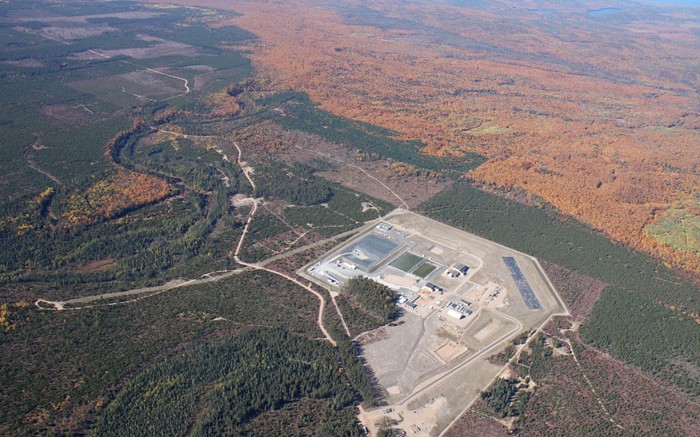VANCOUVER — Lundin Mining (LUN-T) has been shopping for a base metal asset to add to its production portfolio, and on June 12 the company found a partner in Rio Tinto (RIO-N, RIO-L), which was looking to unload its development-stage Eagle nickel-copper mine in northern Michigan.
For a purchase price of US$325 million — which includes a US$250-million payment and US$75 million in project expenditure reimbursements — Lundin gets the keys to Eagle, and the historic Humboldt mill.
Located 45 km northwest of Marquette, Mich., Eagle hosts 5.2 million probable tonnes grading 2.93% nickel, 2.49% copper, 0.64 gram platinum per tonne, 0.43 gram palladium per tonne and 0.08% cobalt. Rio’s resource estimate complies with the Australasian Joint Ore Reserves Committee standards.
“It fits completely within the criteria, which we’ve openly been stating for the past eighteen to twenty-four months, of what we would be looking for in regards to growth,” president and CEO Paul Conibear said during a conference call. “We’ve been searching for a producer or near-production asset that is high quality and carries low operating costs. We have been putting a lot of effort into identifying a copper asset in production, but we’ve yet to find anything that would be adding value in the marketplace, so we have also been looking at polymetallic opportunities.”
Lundin was rumoured to be involved in bidding for BHP Billiton’s (BHP-N, BLT-L) Pinto Valley copper mine, which ended up going to Capstone Mining (CS-T) for US$650 million, and Conibear says the company had been negotiating to sell four unnamed assets that had not provided adequate margins for Lundin shareholders.
And margins are Lundin’s main concern. Though other acquisitions offered larger deposits and a longer mine life, Eagle’s high nickel grades and strong by-product credits should position it in the lowest quartile of the nickel-producer cost curve. Cash costs over the first three years of production are expected to average US$2 per lb. nickel.
Lundin’s purchase price was also attractive. Considering Rio has already invested US$355 million in project development at Eagle — with total capital expenditures estimated at US$770 million — Lundin is paying cash value for pre-developed infrastructure at the site, with the in-situ reserves appearing to be a bonus.
Eagle will be an underground operation, with its orebody running from surface to 300 metres depth, and Rio has advanced a mine ramp, with 3,000 metres completed to date. Ore will be transported 105 km by truck to the refurbished Humboldt mill, with planned production of 2,000 tonnes per day using long-hole open stopes. The mill is comprised of a conventional crushing, grinding and flotation circuit that will produce separate nickel and copper concentrates.
Eagle’s annual production over its first three years is expected to be 23,000 tonnes nickel and 20,000 tonnes copper, along with by-product credits of precious metals and cobalt.
According to Conibear, Eagle will bump Lundin’s copper production by 15–20% once in production, as well as fill a void left by the company’s Aguablanca nickel-copper mine in Spain, which it expects to close in 2015.
“Scale-wise Eagle adds meaningfully to our revenue line, metal production and position in the industry. I’ll point out though we did not do this deal for size, we did the deal for margins,” Conibear says. “Eagle is affordable from our existing cash position, it does not stretch our current balance sheet and there is certainly no intent to do equity placements, or any other financial raises people are typically concerned about when acquiring a new asset.”
Lundin will fund its Eagle purchase from a current net cash balance of around US$250 million, as well as a portion of a US$350-million revolving credit facility. On top of the cost for the acquisition Lundin will be on the hook for US$400 million in development costs needed to get Eagle ramped-up by late 2014. The company intends to fund the project through its existing credit facility from ongoing cash flow, and possibly an expanded debt facility, or similar funding instrument.
Though Eagle’s reserves translate to an eight-year mine life, Conibear says the project has good exploration upside. The Eagle West and Eagle Deep deposits reach 900-metre depths, while the nearby Eagle East discovery has yet to have its maiden resource calculated.
“[Rio] until just recently had put a lot of effort into drilling the project, though they’ve backed off . . . they are taking on capital investment, and knowing they will be moving the asset onto a new owner,” Conibear says. “They have had high success in increasing the reserves and contained metal at Eagle, and we’ll continue that focus.”
The Rio and BHP deals mark a recent acquisition shift where mid-tier producers have benefitted from cost-cutting measures at large-cap companies.
Lundin shares jumped 5%, or 20¢, following news of the acquisition to close at $4.18 at press time. The company has traded within a 52-week range of $3.69 and $5.54, and maintained 584 million shares outstanding for a $2.4-billion market capitalization.


Be the first to comment on "Lundin pulls trigger on US$325M Eagle deal"